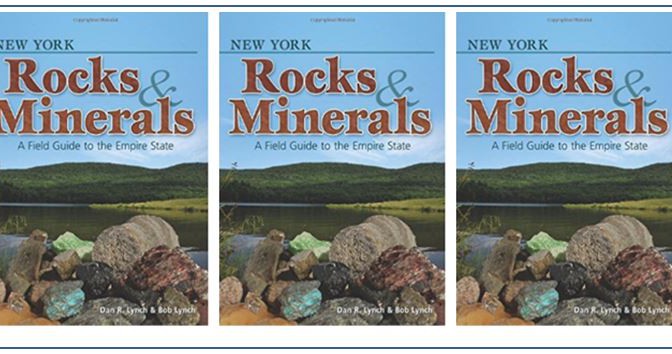BOOK REVIEW: New York Rocks and Minerals: A Field Guide to the Empire State, by Dan and Bob Lynch (2016)
There is a new publication available entitled “New York Rocks and Minerals: A Guide to the Empire State”. It is authored by Dan and Bob Lynch and published by Adventure Publications of Cambridge, MN. The 2016 book is available online for less than $20 on Amazon.
For each of 105 rocks, minerals, and fossils found in New York State this book provides a page of pictures designed to illustrate the specimen’s most characteristic identifying traits and an opposing page providing information on environment, what to look for to identify it, size, color, occurrence, and a notes section with other pertinent information. The format and presentation is very easy to use. In addition, beginners should enjoy the several page overview of New York geology. The 14 page “Quick Identification Guide” based on color and then expanding into other properties may be just the ticket for some.
The book does not provide specific locations where each mineral, fossil or rock type can be found or collected. Rather it provides geographic or geological regional information in the form of a small inset map for each entry. If you are looking for a book full of locations for collecting you will be disappointed.
Several Wayne County Gem and Mineral Club members commented favorably about the photographs used in the book. Instead of providing pictures of museum quality specimens, the book depicts average specimens much like ones a hiker or collector might encounter. Another positive is the size of the book. Measuring just 4.25” across and 6” high, the book will fit into a car’s glove compartment, the outside pocket of a backpack, or even in a modest sized vest or pants pocket. It not only is a field guide, but it can be used as one!
With only a little over 100 entries covering fossils, minerals and rocks, the book is not, nor was it intended to be, a comprehensive treatise of New York rocks and minerals. For example, in the fossil area, there are separate entries for eurypterid and for trilobite, however reef builders and colonial animals are merged into single entries and brachiopods and echinoderms are merged into a single entry entitled aquatic animals. The book seems more complete for minerals. Although some like tourmaline, plagioclase, and scapolite are covered as mineral groups, the book does include somewhat exotic minerals like chrysoberyl, warwickite, tennantite, and even löllingite.
In whole, it is a useful book for the beginner or intermediate New York collector to have at his/her disposal, and, of course, most advance collectors end up acquiring all that is written about their local region anyway. For less than $20 including shipping, most New York rockhounds will probably want one.
